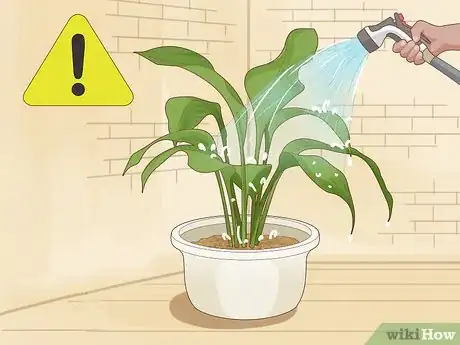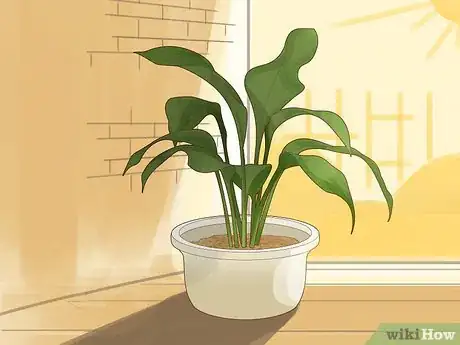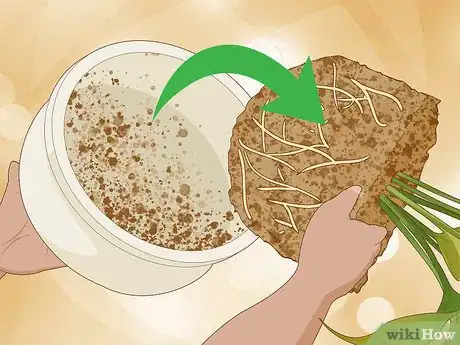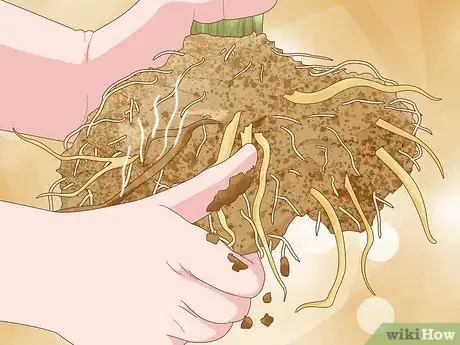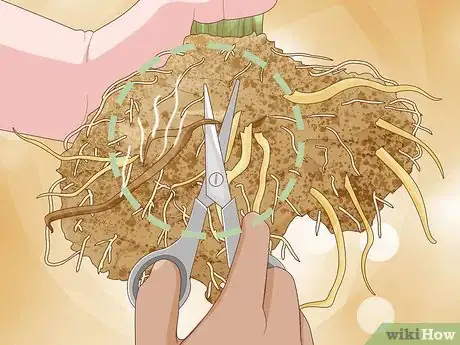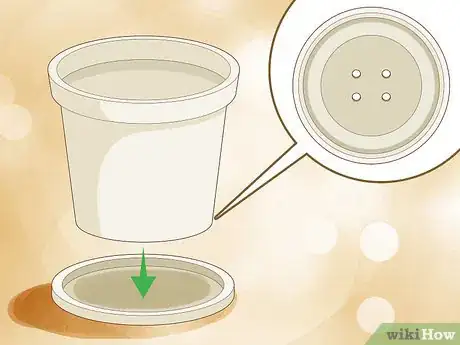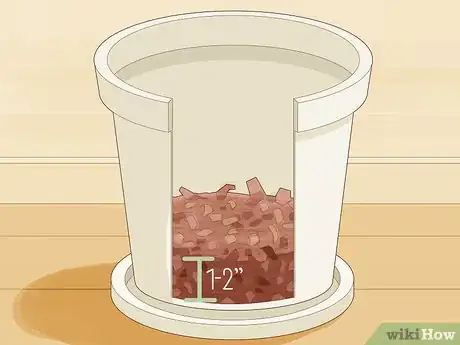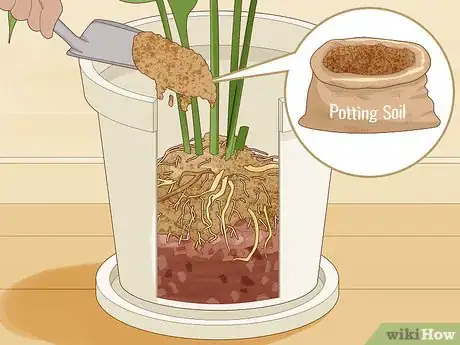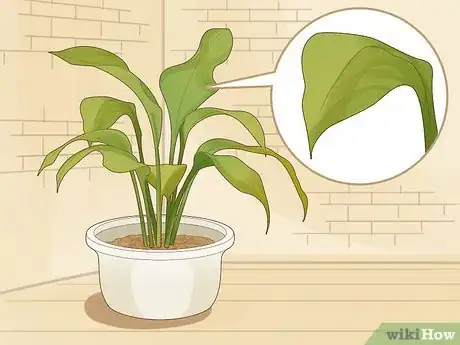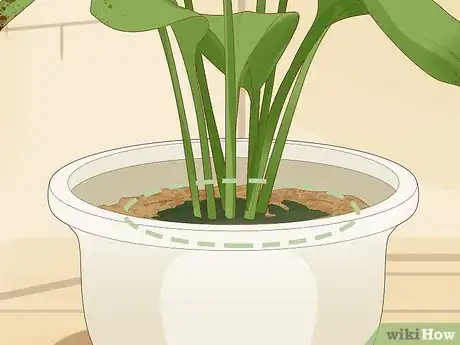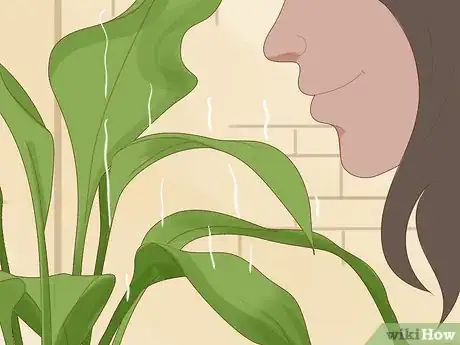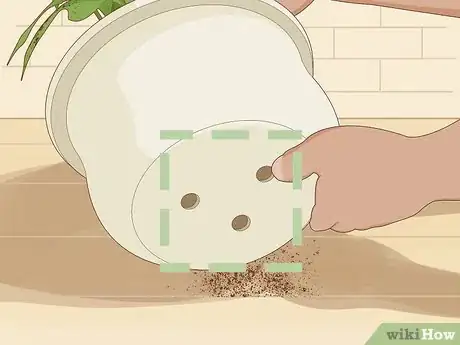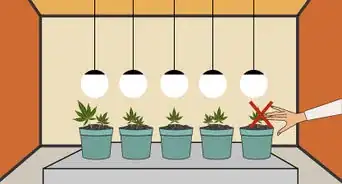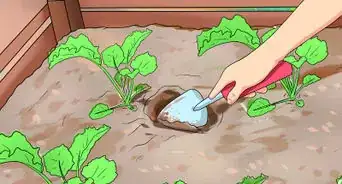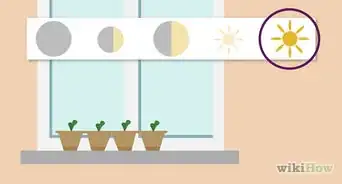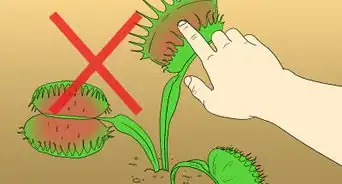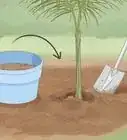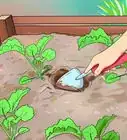This article was co-authored by Chai Saechao and by wikiHow staff writer, Danielle Blinka, MA, MPA. Chai Saechao is the Founder and Owner of Plant Therapy, an indoor-plant store founded in 2018 based in San Francisco, California. As a self-described plant doctor, he believes in the therapeutic power of plants, hoping to keep sharing his love of plants with anyone willing to listen and learn.
wikiHow marks an article as reader-approved once it receives enough positive feedback. In this case, 86% of readers who voted found the article helpful, earning it our reader-approved status.
This article has been viewed 572,595 times.
When you’re trying to take good care of your plants, it’s easy to overwater them. This typically happens to potted plants because the water can’t drain away from the roots. Unfortunately, overwatering can drown your plants and kill them. Luckily, you may be able to save your overwatered plants by drying out the roots before it’s too late.
Steps
Drying out the Roots
-
1Stop watering the plant while it dries out. If you think your plant is overwatered, take a break from watering it. Otherwise, the problem will continue to get worse. Don’t add more water to the pot until you’re sure the roots and soil are dry.[1]
- This can take several days, so don’t worry if there’s a big gap between waterings.
-
2Bring the plant into the shade to protect the upper leaves. When a plant is overwatered, it has trouble transporting water to its upper extremities. This means that the top of the plant is vulnerable to drying out if it’s left in the sun. To help preserve the plant, bring it into the shade if it’s not already shaded.[2]
- You can put the plant back in the sun once it’s stabilized.
Advertisement -
3Tap the sides of the pot gently to loosen the plant and soil. Use your hand or a small shovel to gently tap the sides of the pot. Do this several times on different sides to loosen the soil and roots. This can create air pockets that will help your roots dry.[3]
- Additionally, tapping the sides of the pot will make it easier to remove your plant from the pot.
-
4Slide your plant out of the pot to check the roots and speed up drying. While you don’t have to remove your plant from the pot, it’s best to go ahead and do it. This helps your plant dry out faster and allows you to re-plant it in a pot that has better drainage. To remove it easily, use 1 hand to hold the base of the plant just above the soil. Then, slowly turn the plant over and shake the pot with your other hand until the root ball slides out.[4]
- You should be holding the plant upside down in your hand.
-
5Use your fingers to remove the old soil so you can see the roots. Gently break up the soil so that it will fall away from the roots. Lightly brush it away with your fingers so that the roots don’t get damaged.[5]
- If the soil looks moldy or green from algae, discard it because it will contaminate your plant if you re-use it. Similarly, throw it out if it smells like decay because it likely contains root rot.
- If the soil looks fresh and clean, you may be able to re-use it. However, it’s best to use fresh potting soil just to be safe.
-
6Prune away brown, stinky roots with pruning shears or scissors. Healthy roots are white and firm, while rotting roots will be soft and look brown or black. Use pruning shears or scissors to trim as much of the rotting roots away as possible, saving the healthy roots.[6]
- If most or all of the roots look rotten, you might not be able to save the plant. However, you can try trimming it down to the base of the roots and then replanting it.
Did You Know? The rotting roots are becoming compost material, so they’ll smell like dead and decaying matter. If you don’t trim away these roots, the plant will continue to die.
-
7Trim away dead leaves and stems using pruning shears or scissors. Cut off brown and dry leaves and stems first. If you trimmed off a lot of the root system, you’ll also need to prune away some of the healthy part of the plant. Begin trimming at the top and remove enough leaves and stems so that the plant is no more than twice the size of its root system.[7]
- If you’re not sure how much to cut off of the plant, prune away about the same amount from the plant as your did from the roots.
Re-Potting the Plant
-
1Transfer your plant to a pot that has drainage holes and a tray. Look for a pot that has tiny holes on the bottom so that excess water can drain away from the plant. This prevents the water from settling around the root ball and rotting it. Get a tray to put under your pot if it doesn’t come with one. The tray will catch the excess water so it doesn’t stain the surface below your pot.[8]
- Some pots have a tray attached to them. If this is the case for your pot, check the inside of the pot for drainage holes, as you won’t be able to remove the tray.
Tip: If the pot you were using has drainage holes, it’s okay to return the plant to its pot. However, wash the pot out well with a mild detergent first to remove any remains of rot, compost material, mold, and algae.[9]
-
2Add 1 to 2 in (2.5 to 5.1 cm) of mulch at the bottom of the pot for drainage. While this is optional, it will help you prevent overwatering in the future. Simply layer the mulch at the bottom of the pot, estimating about a 1 to 2 in (2.5 to 5.1 cm) layer. Leave the mulch loose instead of packing it down.[10]
- The mulch will help the water drain out of the pot faster so it doesn’t drown your roots.
-
3Add new potting soil around the plant if necessary. If you removed moldy or algae-covered soil or your new pot is bigger, you’ll need to add fresh potting soil. Pour the new soil around the roots of your plant. Then, fill up the rest of the pot until you reach the base of the plant. Lightly pat the top of the soil to make sure the plant will stay in place.[11]
- If necessary, add a little more potting soil after you pat down around the plant. You don’t want to see any exposed roots.
-
4Water your plant only when the top layer of soil feels dry. When you first re-pot the plant, pour water over the soil to moisten it. Then, check the soil before you water the plant again to make sure the soil feels dry, which means the plant needs water. When you water the plant, pour the water directly over the soil so that it goes to the roots.[12]
- It’s best to water your plant in the morning so that the light from the sun will help dry it faster.
Recognizing an Overwatered Plant
-
1Check if the leaves are light green or yellow. When a plant is overwatered, the color of the leaves starts to change. Look to see if the green is leaving the leaves, turning them pale green or yellow. You may also notice splotches of yellow on the leaves.[13]
Note: This happens because the plant’s normal photosynthesis processes can’t happen if it’s too wet. That means the plant isn't able to get nourishment.
-
2Notice if the plant isn’t growing or has brown spots. When the roots are drowning in water, they can’t supply water to the upper parts of the plant. Additionally, the plant can’t get nutrients from the soil. That means it will start to wilt and die. Check to see if your plant is struggling to produce new leaves or stems or has foliage that is dying.[14]
- Since your plant can also die from not being watered enough, you might feel unsure about whether or not it’s under or overwatered. If you know you’ve been watering the plant but it’s still dying, overwatering is likely the culprit.
-
3Look for mold or algae at the base of the stem or the top of the soil. When there’s too much water in the pot, you may see green algae or fuzzy black or white mold starting to grow on the surface of the soil or on the base of the stem. This is a sign that the plant is being overwatered.[15]
- You may see tiny spots of mold or algae, or it could be widespread. Any mold or algae is cause for concern.
-
4Sniff the plant to see if there’s a foul, musty odor. If water sits on the roots for too long, it will start to rot them. When this happens, the roots will give off an odor of decay. Place your nose close to the top layer of the soil and sniff it to see if you detect an odor.[16]
- It’s possible that you won’t be able to smell root rot if it’s just started or if your soil is very deep.
-
5Check for drainage holes at the bottom of the pot. If your pot doesn’t have holes at the bottom to allow for drainage, it’s likely that your plant is getting overwatered. That’s because water gets trapped at the bottom of the pot. It’s best to remove the plant from the pot to check it for root rot. Then, create holes in your pot or transfer the plant to a pot that has holes.[17]
- You can create holes in a plastic pot using a knife or screw driver. Use the knife or screwdriver to carefully puncture the bottom of the pot.
- If your pot is ceramic or clay, it’s best not to try to make holes. You'll likely end up breaking or damaging the pot.
Expert Q&A
Did you know you can get expert answers for this article?
Unlock expert answers by supporting wikiHow
-
QuestionWhat causes brown spots on a plant if it isn't overwatered?
 Chai SaechaoChai Saechao is the Founder and Owner of Plant Therapy, an indoor-plant store founded in 2018 based in San Francisco, California. As a self-described plant doctor, he believes in the therapeutic power of plants, hoping to keep sharing his love of plants with anyone willing to listen and learn.
Chai SaechaoChai Saechao is the Founder and Owner of Plant Therapy, an indoor-plant store founded in 2018 based in San Francisco, California. As a self-described plant doctor, he believes in the therapeutic power of plants, hoping to keep sharing his love of plants with anyone willing to listen and learn.
Plant Specialist Well, brown spots could also mean that your plant is dehydrated and you aren't watering it enough as well. Outside of watering issues though, brown spots may develop if the plant is getting too much sun. Try transferring the plant to an area with a little more shade and see if the brown spots go away.
Well, brown spots could also mean that your plant is dehydrated and you aren't watering it enough as well. Outside of watering issues though, brown spots may develop if the plant is getting too much sun. Try transferring the plant to an area with a little more shade and see if the brown spots go away. -
QuestionWhat does an overwatered plant look like?
 Chai SaechaoChai Saechao is the Founder and Owner of Plant Therapy, an indoor-plant store founded in 2018 based in San Francisco, California. As a self-described plant doctor, he believes in the therapeutic power of plants, hoping to keep sharing his love of plants with anyone willing to listen and learn.
Chai SaechaoChai Saechao is the Founder and Owner of Plant Therapy, an indoor-plant store founded in 2018 based in San Francisco, California. As a self-described plant doctor, he believes in the therapeutic power of plants, hoping to keep sharing his love of plants with anyone willing to listen and learn.
Plant Specialist
-
QuestionWhat if the leaves on my ficus tree are turning yellow and falling off?
 Community AnswerThis may be an indication of water stress. Ficus leaves may also turn yellow if humidity is too low. This can occur if the plant is kept indoors in the winter when the air is likely too dry for it.
Community AnswerThis may be an indication of water stress. Ficus leaves may also turn yellow if humidity is too low. This can occur if the plant is kept indoors in the winter when the air is likely too dry for it.
Things You'll Need
- Shady area
- Pot with drainage holes
- Tray for under pot
- New potting soil
- Mesh baking rack
- Spray bottle
- Small pruning shears or scissors
- Small shovel or trowel (optional)
- Mulch (optional)
- Water
References
- ↑ https://seedtocrop.net/2019/01/how-to-save-your-overwatered-plants/
- ↑ https://seedtocrop.net/2019/01/how-to-save-your-overwatered-plants/
- ↑ https://seedtocrop.net/2019/01/how-to-save-your-overwatered-plants/
- ↑ https://www.architecturaldigest.com/story/houseplant-care-overwatering-and-drainage
- ↑ https://seedtocrop.net/2019/01/how-to-save-your-overwatered-plants/
- ↑ https://www.theguardian.com/lifeandstyle/2017/nov/12/how-to-rescue-your-houseplants-from-overwatering
- ↑ https://www.theguardian.com/lifeandstyle/2017/nov/12/how-to-rescue-your-houseplants-from-overwatering
- ↑ https://www.architecturaldigest.com/story/houseplant-care-overwatering-and-drainage
- ↑ https://www.theguardian.com/lifeandstyle/2017/nov/12/how-to-rescue-your-houseplants-from-overwatering
- ↑ https://seedtocrop.net/2019/01/how-to-save-your-overwatered-plants/
- ↑ https://seedtocrop.net/2019/01/how-to-save-your-overwatered-plants/
- ↑ https://www.architecturaldigest.com/story/houseplant-care-overwatering-and-drainage
- ↑ Chai Saechao. Plant Specialist. Expert Interview. 20 February 2019.
- ↑ https://seedtocrop.net/2019/01/how-to-save-your-overwatered-plants/
- ↑ Chai Saechao. Plant Specialist. Expert Interview. 20 February 2019.
- ↑ https://balconygardenweb.com/signs-of-overwatering-how-to-save-an-overwatered-plant/
- ↑ https://www.architecturaldigest.com/story/houseplant-care-overwatering-and-drainage
About This Article
If your plant's leaves start turning yellow or wilting despite regular watering, it could be a sign that it's overwatered. To save an overwatered plant, the first thing you should do is temporarily stop watering it. Make sure the drainage holes in your plant's pot aren't clogged, and gently shake the pot to loosen the soil and introduce some air into it. Place your plant in a shady spot and give it a few days for the soil to dry out. If your plant continues to decline after a few days, it's time to repot it. Carefully remove the plant from its pot. Shake off the excess soil that's sticking to the roots, then repot the plant in a new pot with some dry potting mix. Wait a week before watering your plant so the roots have time to dry out. Once your plant starts to bounce back, move it back to its original location and start watering it again. To learn how to tell if your plants have been overwatered, keep reading!
